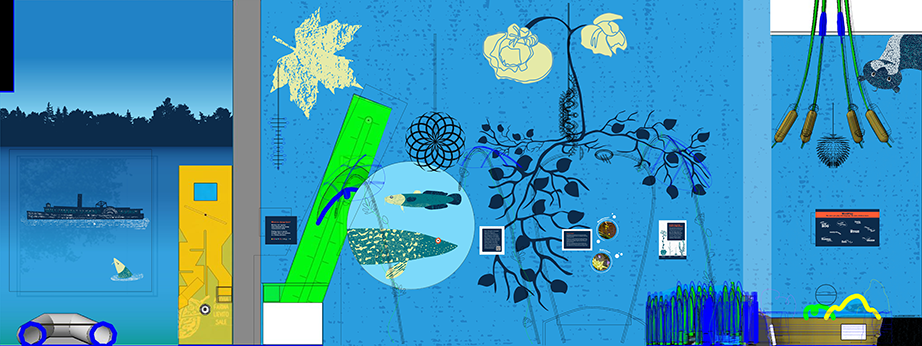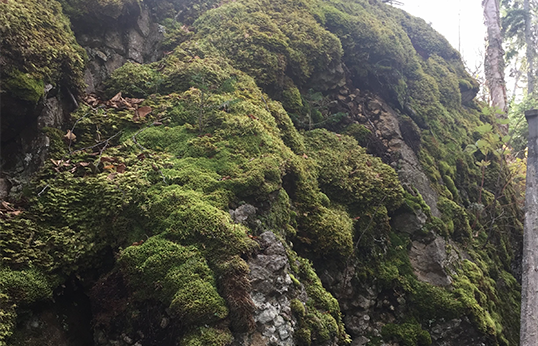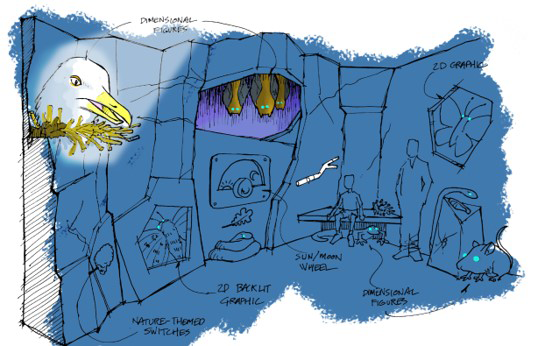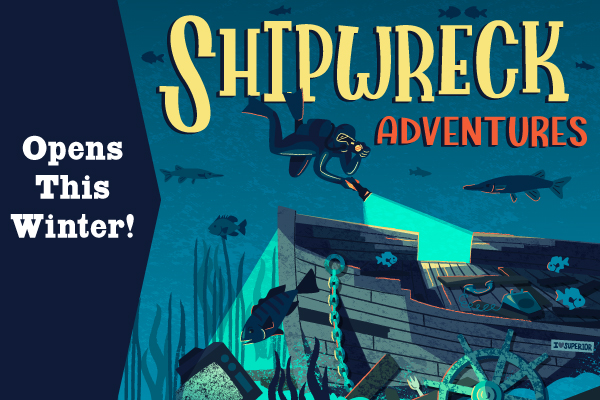The Making of Shipwreck Adventures Home

Bringing the North Shore to Life
Although exploring a sunken ship at the bottom of the lake is central to Shipwreck Adventures, the exhibit reaches beyond the water. By stepping into cliffs and coves and walking under larger-than-life plants, visitors will be transported to an immersive world that takes them to the North Shore of Lake Superior.
When senior exhibit developer Mary Weiland was conceptualizing the new exhibit, she knew from the beginning that she wanted to highlight more than just the shipwreck. With her background in Minnesota history, she understood that the North Shore – particularly the lakeshore around the Grand Portage area – was an integral part of the story of the J.S. Seaverns. After all, the rocky coast and tumultuous waters are a big reason Lake Superior has claimed so many ships. Thus began her research into how the exhibit could bring the North Shore to life.
To learn more about life on the North Shore, Mary and other team members met with the Grand Portage Tribal Council, whose members generously shared their deep knowledge about the biology and microhabitats of the area. Hearing directly from members of the Grand Portage First Nation informed the team’s decisions about which plants and animals to highlight in the exhibit. Team members were given a guided tour through the woods and lakeshore, which gave the exhibit team confidence in the different ways they could represent the natural world on the North Shore.
An Exhibit Inspired by the North Shore
Throughout Shipwreck Adventures, visitors will find whimsical interpretations of plants and animals that are found along the north shore of Lake Superior.
As you approach the cliffs and coves area, you’ll see patches of touchable moss and lichen on rocks that look like the natural Basaltic rock found on the cliffs of the North Shore. The lichen and moss are made from a variety of fabrics with different textures and shapes, designed and fabricated by the museum’s prop specialist, Abbey Nielsen. Walk inside the cove to see and hear animals of all shapes and sizes tucked in the rocky wall – a taiga alpine butterfly, woodland jumping mouse, blue-spotted salamander and more. The animals are brought to life by local artist Amy Toscani with direction from the exhibit team. A turn of the wheel transforms the cove from night to day, with twinkling stars and sounds of animals active at night (such owls and crickets ) replaced by the rising sun and a chorus of chirping birds.
On the opposite side of the exhibit, a playful shoreline with large plants and giant fish commands attention. Visitors carefully move through a patch of oversized grasses as they explore the shoreline under a canopy of cattails and giant leaves. Don’t miss the towering, carnivorous bladderwort plant above as visitors try their hand at helping the plant snack on a tasty bug. The giant plants in this part of the exhibit are based on real plants that grow near Grand Portage in the far northeast corner of the state. Their fragile existence in Minnesota is highly unusual. They survive because of the localized, arctic-like conditions that exist in certain microhabitats along the north shore of Lake Superior.
As part of the shoreline, a special place for our youngest visitors sits off to one side. Geared toward children under the age of two, the Tot Spot incorporates sensory play and whole-body exploration. Strategically placed seating allows adults to play with their tots and keep an eye on other parts of the exhibit.
As visitors explore the world in Shipwreck Adventures, inspirations of the North Shore can be found at every turn. Keep a close eye out and you never know what you’ll discover.
A photo of moss and rocks taken by Mary during a trip to Grand Portage. The photo later served as inspiration for rocks and moss found in Shipwreck Adventures.
An concept drawing of how visitors might encounter different animals in the cliffs and coves section of the exhibit.
An early sketch of a giant, interactive bladderwort plant and bug.
An Exhibit Inspired by the North Shore
Throughout Shipwreck Adventures, visitors will find whimsical interpretations of plants and animals that are found along the north shore of Lake Superior.
A photo of moss and rocks taken by Mary during a trip to Grand Portage. The photo later served as inspiration for rocks and moss found in Shipwreck Adventures.
As you approach the cliffs and coves area, you’ll see patches of touchable moss and lichen on rocks that look like the natural Basaltic rock found on the cliffs of the North Shore. The lichen and moss are made from a variety of fabrics with different textures and shapes, designed and fabricated by the museum’s prop specialist, Abbey Nielsen. Walk inside the cove to see and hear animals of all shapes and sizes tucked in the rocky wall – a taiga alpine butterfly, woodland jumping mouse, blue-spotted salamander and more. The animals are brought to life by local artist Amy Toscani with direction from the exhibit team. A turn of the wheel transforms the cove from day to night, with sunshine replaced by twinkling stars and the sights and sounds of nocturnal animals, such as the northern long-eared bat and a herring gull.
An concept drawing of how visitors might encounter different animals in the cliffs and coves section of the exhibit.
On the opposite side of the exhibit, a playful shoreline with large plants and giant fish commands attention. Visitors carefully move through a patch of oversized grasses as they explore the shoreline under a canopy of cattails and giant leaves. Don’t miss the towering, carnivorous bladderwort plant above as visitors try their hand at helping the plant snack on a tasty bug. The giant plants in this part of the exhibit are based on real plants that grow near Grand Portage in the far northeast corner of the state. Their fragile existence in Minnesota is highly unusual. They survive because of the localized, arctic-like conditions that exist in certain microhabitats along the north shore of Lake Superior.
An early sketch of a giant, interactive bladderwort plant and bug.
As part of the shoreline, a special place for our youngest visitors sits off to one side. Geared toward children under the age of two, the Tot Spot incorporates sensory play and whole-body exploration. Strategically placed seating allows adults to play with their tots and keep an eye on other parts of the exhibit.
As visitors explore the world in Shipwreck Adventures, inspirations of the North Shore can be found at every turn. Keep a close eye out and you never know what you’ll discover.





